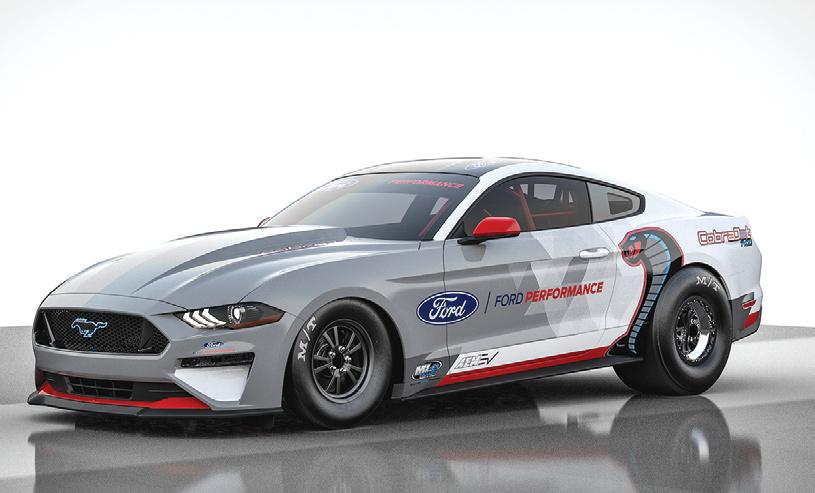
16 minute read
Starting Lines
Dodge Continues Challenger 50th Anniversary Celebration with New Options
As Muscle Car season revs into gear, Dodge has announced it will be continuing the 50th anniversary celebration of the Challenger with a new 50th Anniversary Commemorative Edition and a new colour option. The new edition will be available on the 2020 Challenger R/T, Scat Pack 392 and Scat Pack 392 Widebody models, including exclusive features such as a Satin Black, hand-painted hood, model-specific fender badges, a Challenger 50th Anniversary grille and spoiler badges and “Gold School” 20-in. wheels. The Illuminated Air Catcher headlamps feature LED-illuminated “50” logos while a Satin Black “Dodge” taillamp badge is also featured. The Commemorative Edition features Gunmetal brake colour when fitted with Brembo brakes, available on R/T, standard on Scat Pack 392 and Scat Pack 392 Widebody. Inside of all the Commemorative Editions is a throwback-inspired interior with Nappa leather-faced and Alcantara suede performance seats, a real carbon fibre IP and console bezels, white-faced gauges with yellow accents and premium floor mats with the “50” logo. The Challenger 50th Anniversary Limited Edition is available in Go Mango for Canada, while the new Commemorative Edition is available in Smoke Show, Granite, Indigo Blue, Octane Red, Pitch Black, Triple Nickel and White Knuckle. In addition, Smoke Show joins the Dodge colour lineup for both the Challenger and Charger models.
Advertisement




Volume 18, Issue No. 3 June / July 2020 Second Class Mailing Agreement #40050183
Publisher: Dean Washington dean@rpmcanada.ca
Associate Publisher: David Symons david@rpmcanada.ca
Managing Editor Jordan Allan jordan@rpmcanada.ca
Distribution Manager: Brenda Washington brenda@rpmcanada.ca
Copy Editor: Gerry Frechette gerryf@rpmcanada.ca
Advertising Sales: Elaine Fontaine elaine@rpmcanada.ca
Contributing Writers / Photographers: Jordan Allan Stefanie Galeano-Zalutko John Gunnell Cam Hutchins Benjamin Yong
Muscle Car Plus Magazine is published six times per year by RPM Media Inc.
2460 Kingsway Avenue Port Coquitlam, BC, Canada V3C 1T4
TELEPHONE: (604) 629-9669
FAX: (778) 285-2449 TOLL FREE: 1-888-500-4591
EMAIL: info@rpmcanada.ca WEBSITE: www.rpmcanada.ca
Alfa Romeo Announces 110th Anniversary Heritage Content Package

Right about the time this issue hits shelves and mailboxes around Canada, Alfa Romeo will be celebrating its 110th Anniversary on June 24, 2020. To mark the occasion, the brand is launching a comprehensive heritage package that highlights key moments in its history. Headlining the package is an interactive e-book which details the company all the way back to its beginning in 1910 when the first A.L.F.A, the 24 HP, was introduced. As mentioned, the book details the company all the way back to its roots and also provides a considerable number of facts presented in a “Did you Know?” format. Below is a preview of some of those facts which diehard Alfa followers probably already know, but if you don’t, here is a quick preview:
• Did you know the Alfa Romeo logo combines the emblem of the city of Milan and the “Biscione Visconteo,” the coat of arms of the Visconti family, which ruled medieval Milan?
• Did you know Alfa Romeo won the very first Formula 1 championship in 1950? And the second Formula 1 championship in 1951, with Juan Manuel Fangio securing the title?
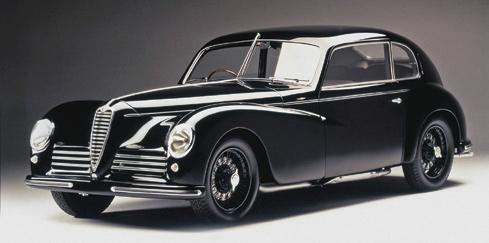
Pick up your copy at your local Performance Shop or at the following participating locations:
• Did you know Enzo Ferrari drove for the Alfa Romeo racing team prior to leaving to establish his own car company?
. Did you know Hollywood stars from the 1940s aspired to drive Alfa Romeos, especially rare models such as the 6C 2500 Super Sport?
. Did you know that the Alfa Romeo 156 D2 race car introduced in 1998 went on to win 13 touring car championships?
All of these facts are detailed in the package, including all of the photography, much of which comes from the archive at the Museo Storico Alfa Romeo in Arese, Italy, and a short video synopsis. For more information, please visit www.alfaromeo.ca. MUSCLE CAR PLUS MAGAZINE JUNE/JULY 2020
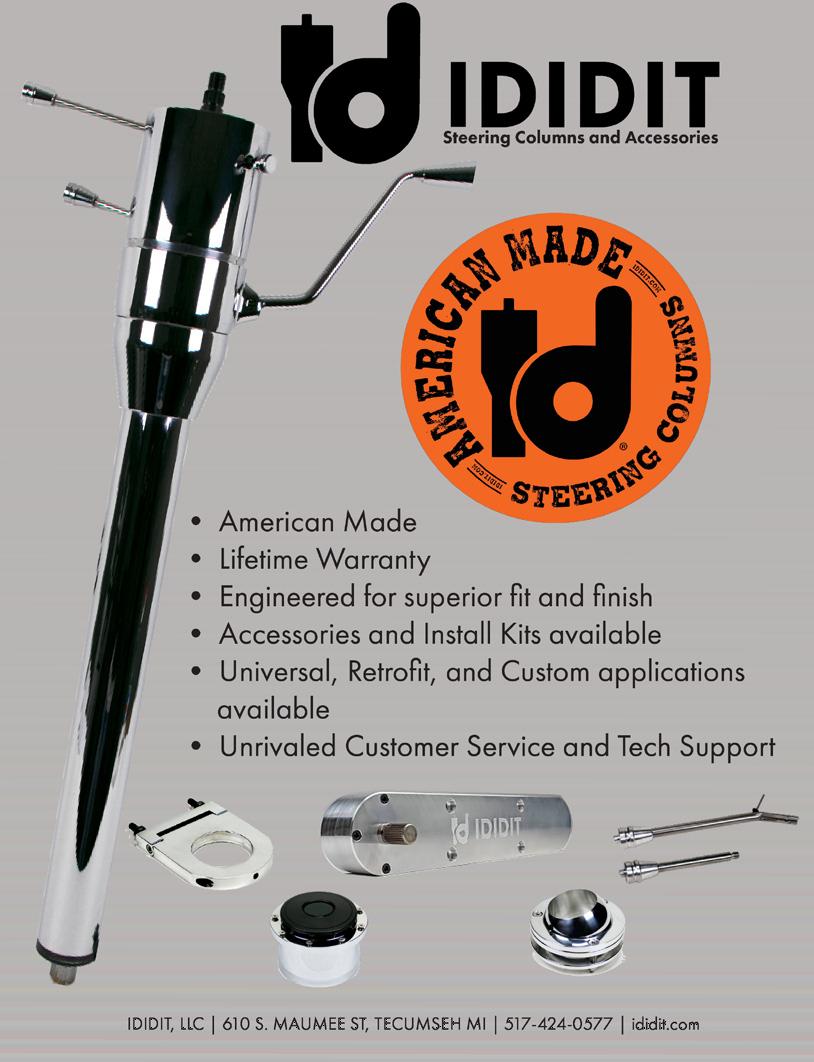


Ford Mustang Mach 1 Returning for 2021 Model Year Ford has recently announced that the Mustang Mach 1 is set to make its triumphant return as a limited-edition pinnacle of style, handling and 5.0L V8 performance. The iconic fastback coupe that originally debuted in the golden era of muscle cars in the late 1960s has a special place in Mustang history and, like the original, bridges the gap between the Mustang GT and Shelby models. It provides V8 power, unique functional aerodynamics enhancements and competition-capable suspension upgrades. The new Mach 1 will become the most track-capable 5.0L Mustang ever thanks to a newly designed front end plus the addition of Ford performance parts borrowed from the Shelby GT350 and GT500 models. The specially calibrated 5.0L V8 will produces 480 horsepower at 7,000 rpm and 420 lb.-ft. of torque at 4,600 rpm. The car comes standard with a Tremec 3160 6-speed manual transmission from the GT350 which, for the first time in a Ford, is fitted with rev-matching and is paired with the GT350 oil cooler system and Mustang GT’s twin-disc clutch and short-throw shifter. Also available is a 10-speed SelectShift automatic transmission with an upgraded torque converter and unique calibration to optimize torque capability, shift character and overall performance. A Handling Package is offered as well for models with the manual transmission that provides a larger front splitter, new front wheel lip moldings and a low-gloss Magnetic swing spoiler with a Gurney flap and rear tire spats. Finally, the vehicle’s most aerodynamically important upgrade is likely the new underbelly pan which extends 20-in. further rearward than on a Mustang GT with the Performance Pack to smooth and increase airflow under the front of the car. The all-new and limited-edition Mustang Mach 1 will arrive in Canadian dealerships in the Spring of next year.
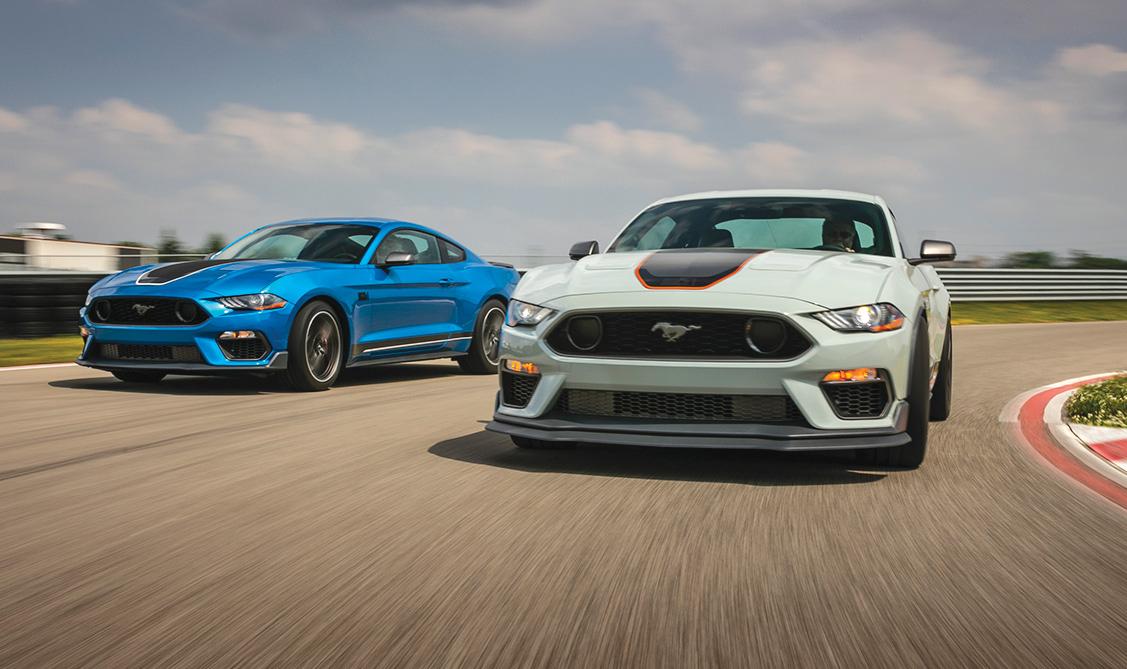

Still Turning Heads

Ray Myles’ 1969 Plymouth Barracuda S
When a young Ray Myles was starting out as a mechanic, he remembers prepping for sale tons of Dart GTs at Vancouver’s Lawson Oates Chrysler, and equipped with the 340 cu. in. V8 and four-speed tranny, the new owners could not crash them quick enough. Since the Plymouth Barracudas were quite expensive for the average young guy looking for a hot car, they were fairly rare. But the Barracuda adds a lot to the mystique of the Muscle and Pony Car era.
Technically, the Plymouth Barracuda was the first Pony Car....launched just two weeks before the Ford Mustang as a model of the venerable Valiant. It shares many of the Valiant’s drivetrain and chassis, as the Mustang did
of the existing Ford Falcon, but while the two Fords had different body designs, the Barracuda was virtually identical except for the sloped rear window. It was an engineering marvel, and at over 14 square feet, was the largest rear window available in America and was designed jointly with PPG, the Pittsburg Plate Glass company.
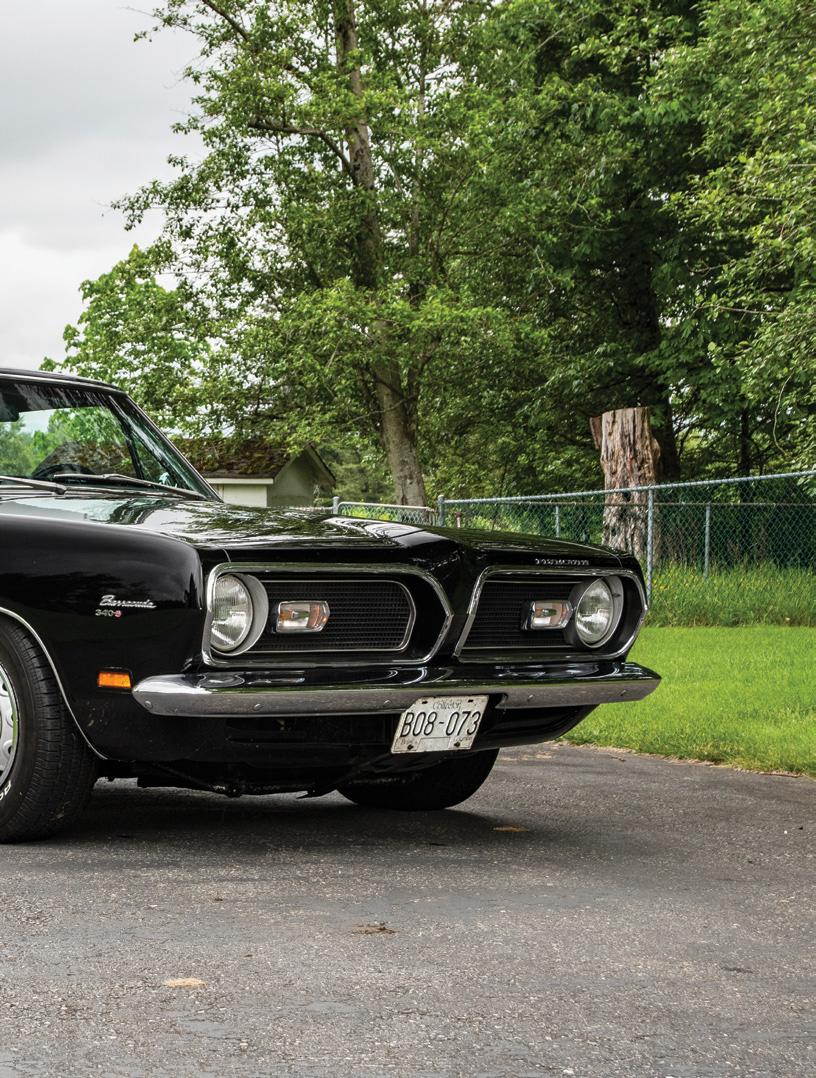
The new car was originally to be called the “Panda” but designer John ‘Dick’ Samsen suggested “Barracuda.” Samsen also worked on the design of the 1955 Ford Thunderbird after working as an aero engineer. Interestingly, the early Plymouth Barracuda was based on the Valiant, but Dodge did not also release a Dart version of the Barracuda.

The Barracuda for 1964 had the same three engine options as the Valiant - base 170 cu. in. Slant Six-cylinder, a 225 cu. in. Slant Six, and the 180-hp 273 cu. in V8. 1964 was the only year for the push-button transmission on the Barracudas, and the first year of the “TorqueFlite” 6-inch (A904) transmission with smaller outside dimensions than previous automatic transmissions. The Barracuda also has the honour of being the Pony Car with the largest available engine, as some specially-modified cars were offered with the monster 440 cu. in. V8s.
Sales were a disappointment at first for Plymouth, selling just a fraction that the Mustang did, but Plymouth kept trying to get it right. The car obviously was a sporty version of the economical Valiant and still had 13-in. wheels as compared to the Mustang’s base 14-in. wheels. They introduced a new, more powerful engine in 1965, dropping the smaller sized 170 six cylinder, except in Canada, and introduced the optional Commando version of the 273 V8. Solid lifters, an aggressive camshaft, 10.5:1 compression ratio and fourbarrel carb boosted the horsepower to 235. For 1965, the Formula S package was available with the Commando V8, larger wheels, 150-mph speedometer, and a tachometer.
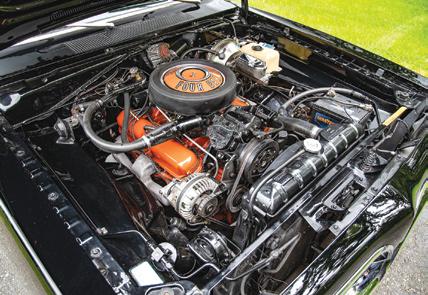
1967 was when the Barracuda took on a life of its own, still sharing much of the chassis of the Valiant. The fastback body was completely changed and the long sloped glass was replaced by a smaller sloping rear window, along with a coupe with a more upright rear window and a convertible. Various engines were added to the line but sales of the 1967 to 1969 models were dismal to say the least. But that equates to a fairly rare car decades later. Interestingly, the 1970 model was released as a Cuda while previous versions were Barracudas except for a small number of specially equipped Cudas as a trim package of the last year of the second generation of the Barracuda.
When Myles was told by a friend of one for sale near Bellis Fair in Bellingham, he had to check it out. The car had been

bought new in Los Angeles by a lady just prior to retiring. It spent its time between L.A. and the desert and the paint had been baked by the hot SoCal sun. The head restraints and tops of the seats had sun damage but otherwise were in very good condition, but an ugly brown. The body was amazing, no rust anywhere and the car had never been hit or taken apart. Myles made a deal with the son who had inherited it from his mother after she passed away.

The car came with factory air conditioning and the windows were tinted by a million packs of cigarettes. The back seat may have only been sat in a few times as it was perfect and although the driver’s manual window operated with some effort, the passenger window was twice as hard to operate and the rear windows were completely seized, and upon inspection, found to have a concrete-like grease coating the mechanism.
The air conditioning reduced the need for open air driving during its 60,000 miles, so the windows probably were not opened much. Normally the dash is covered in a wood decal but for the cars with factory air, the dash inset is just black. This car also came with the deluxe interior, AM radio and “Lighting Package” including the glovebox.
The car had most available options except for the hood-mounted turn signals, right-hand mirror, and bumperettes. It had the 340 cu. in. V8 and 727 three-speed automatic transmission with a “Sure-Grip” posi-traction 3.50:1 rear end. The A-bodies that the Barracuda is based on did not offer power windows or power seats, but this car does have power steering and power brakes.
The car ran perfectly and the original drivetrain still has not needed rebuilding. It was bought to be a cool daily driver, so the dismal “Dung Brown” colour had to go. The matching ugly brown interior, like the exterior, had been baked in the desert sun and was worn out. Originally, the paint choice was black cherry in lacquer, but planning on driving it daily made this choice unwise as it would be impossible to match the paint in case of an accident.
The car would be painted black, and Myles knew from experience, the Barracuda’s body panels were not all the straightest, so the cars that were to be painted black at the factory often had hand-picked

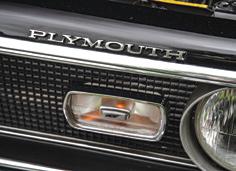
panels to try to minimize the flaws. This Barracuda had flaws galore! Although the car had never been hit, and has never been taken apart, after stripping the paint, more than 300 hours were spent block sanding the body. Once Myles thought it was perfect, his painter showed him how he needed to spend another 100 hours to get it right! It took two days to paint it, first spray it and flash it, then recoat it, then sand it the next day and repaint and clearcoat. This paint was not acrylic enamel but the new “base coat, clear” that was a new thing and proved to give a much better finish.
The extra work paid off, as the car is painted Black with Glasurit paint that was just starting to be the standard of high-quality paint locally 40 years ago. This is the paint the high-end Mercedes were getting sprayed at the time. It cost more than the price Myles paid for the car just to paint it, but 40 years later, the car still looks like it’s had a fresh coat of paint. Keep in mind, this was not always a garage queen; the car was driven two years as a daily driver in the early ‘80s!
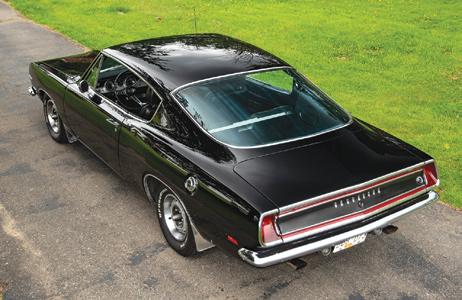
The interior was converted to black using products from Legendary Auto Interiors, including door panels and headliner. The glass was pristine except for the windshield that had some sand blasting from its time in the desert. The glass has not been removed, but the window winding mechanisms have been serviced with fresh lubricants for easy operation. The bumpers were re-chromed and
although many trim pieces were sourced from the wrecking yards, none was better than the ones that originally came with the car.
The four-wheel drum brakes were mediocre at best, so after having the car 20 years, it finally got discs on the front. At 30 years, it got the original sway bars replaced with 1-inch bars front and rear, and that dramatically increased the driving experience. All the 340 cu. in. cars were the Formula S package, and although they all came with heavy-duty suspension, bigger stronger torsion bars up front and stiffer springs in the rear, the original sway bars were too light.
The car runs 1970 Cuda wheels and the tires are getting regular use as the car gets driven a fair amount. As much as can be driven by one owner with a few cool cars including a 1952 Dodge Custom Truck with a 440, as well as a 440 cu. in. 1969 1/2 Super Bee, a 1964 330 two-door sedan Pro Touring with a 6.1 L Hemi, and his first car, a 1954 Ford Victoria two-door hardtop bought in 1964 while he was in high school. The Ford had just had a new motor installed but had been in an accident and had the hood and one front fender mashed. Myles grew up in Vancouver and bought the car with money earned from a paper route...$50, and did the repairs himself. The Ford Victoria had its first car show in 1984, then spent

the rest of her life as a hot rod. It is totally era-correct for the early ‘80s car show scene!

The Barracuda was driven to the Seattle Mopar car shows a few times after first finished, and even up to the Williams Lake open show. Although the sales of the first two generations of Barracuda were not great, the completely redesigned 1970 only sold a little better than the 1969 model, (48,867 1970 Cudas versus 31,987 1969 Barracu

das). The 1971 Cuda sales dropped all the way down to less than any other year previous. Only 16,492 1971 Cudas were sold. The model was dropped after 1974’s run of less than 12,000 units sold.
But the sales numbers mean nothing to Ray Myles, as he has never sold a car. He is lucky enough to have enough property to store his old cars, and to get to go cruising whenever he wants. He still has to do maintenance and as we were photographing the car, he mentioned he had found some better head restraints and was waiting for them to be shipped. So if you see the car at a local show, you could think it is a fresh restoration, but it has actually been restored four times longer than it was “fresh” from the factory. Hard to imagine any 10 year-old car today getting a King’s Ransom-worth of paint and still turning heads 40 years from now!
B&W Insurance represents Hagerty Insurance, the global leader in providing specialty insurance for classic and collector cars. You are an avid car enthusiast. Your antique, hot rod, customized or classic car is unique and requires unique coverage. At B&W our insurance experts understand the coverage and features you need to ensure your investment is protected. Representing all the different insurance companies that provide coverage for collector vehicles, B&W will arrange the coverage best suited to your needs. You are an avid car enthusiast. Your antique, hot rod, customized or classic car is unique and requires unique coverage. At B&W our insurance experts understand the coverage and features you need to ensure your investment is protected. Representing all the different insurance companies that provide coverage for collector vehicles, B&W will arrange the coverage best suited to your needs.


TYLERStamnes Abbotsford 604-853-0077 JUDYDavidson Langley 604-530-9993 We’re experts in the Nuts & Bolts of Collector Car Insurance. Call Tyler or Judy to get the best policy for absolutely the BEST PRICE.
L A N G L E Y 19825 Fraser Hwy. P 604-530-9993 F 604-530-6050 C L O V E R D A L E 306-18690 Fraser Hwy. P 604-575-8454 F 604-575-8452 4-2054 Whatcom Road www.bwinsurance.com P 604-853-0077 F 604-853-0037 A B B O T S F O R D F L E E TWO O D 16007 Fraser Hwy. P 604-597-6555 F 604-597-7434
TOLL FREE 1 866 866 9780
D E LT A / S U R R E Y 108-8434 120 Street P 604-591-7891 F 604-591-5438

